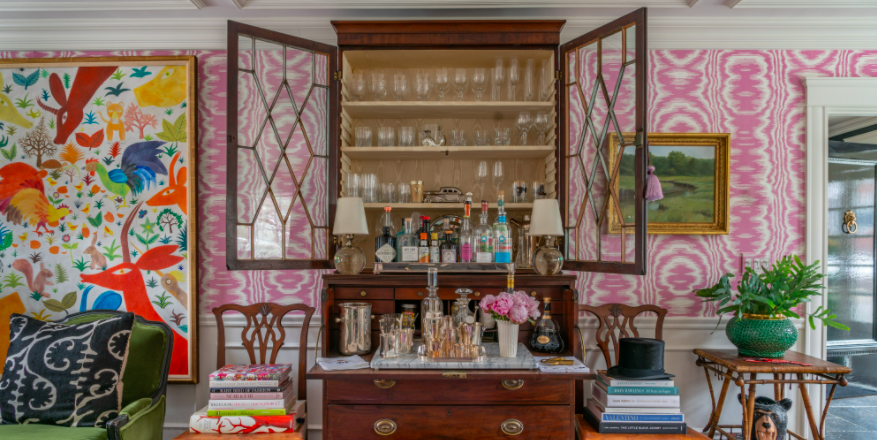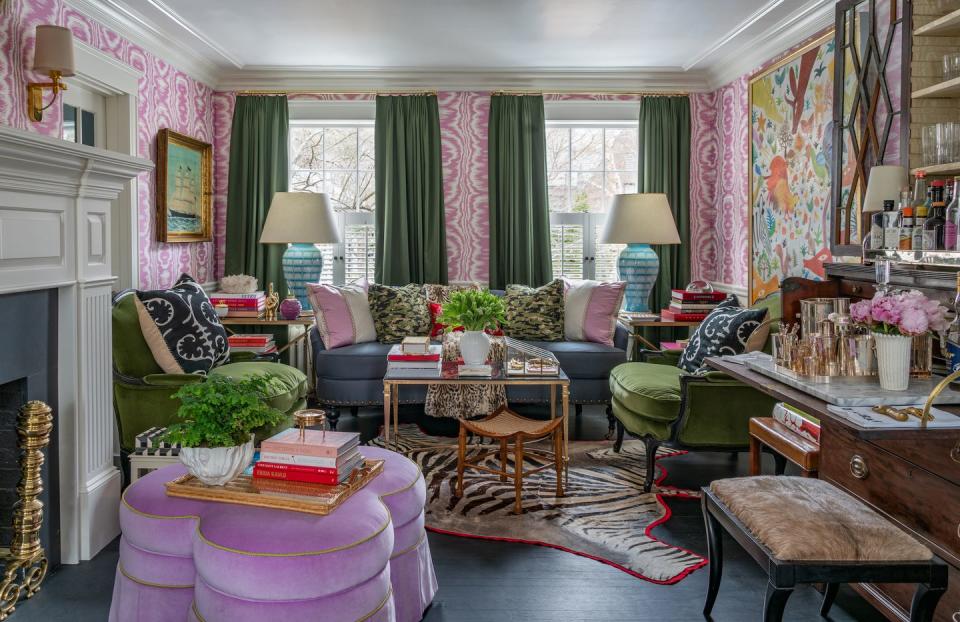How to Successfully Mix Patterns in Your Interiors, According to Designer Liz Caan

Boston-based designer Liz Caan is famous for giving historic homes a vibrant and inviting new life across New England and beyond. She has a keen eye for mixing patterns in a way that both embraces a maximalist spirit and feels like a page out of a traditional design playbook.
"I love a lot of visual stimulation personally, and I have a lot of things," says Caan. "I am constantly collecting and playing around. So much of this pattern play happens naturally and I am conscious of it when I add to the mix. It's kind of a go-all-out-or-it-won't-work method." Here, she shares her best advice for upping your pattern play game while still staying true to your personal design aesthetic and ensuring your home doesn't look too eclectic.
Start with a Color Strategy

Re-designing a room doesn't just affect that one space, even if you have a home that is more closed off to itself. Caan is mindful of how a space will impact the surrounding rooms and how dominant a color should or shouldn't be in light of that.
"I really pay attention to how I weave a color through the house," says Caan. "One color will be more dominant in one room and another in a neighboring room, but all share a few of the same colors."
While the designer has a penchant for bright, happy hues, she balances them with blacks or other deep, rich colors to ground the space and create balance. From here, you've created the perfect foundation to start building and layering with patterns.
Consider the Purpose of Your Space

Caan says your approach to pattern play in a room will be affected by the type of space you're creating. Is it a casual room for lounging? This means the designer will usually lean on light-weight fabrics and casual textiles like linens and hand-blocked cottons. If you're designing a formal dining room or sitting area, she says to save your silks, velvets, and more luxurious patterns for these types of rooms.
"I love a timeless ticking stripe, a buffalo check, toile, florals, and animal prints," says Caan. "I think these patterns always work well together, and they stand the test of time. They can be modernized in fresh colors, on a larger scale, and even executed on a casual linen or beautiful silk." Thinking through how various patterns and fabrics will help a room feel more relaxed or even grander will make deciding which ones to use that much easier.
Don't Overthink Your Art

Whether you're an avid collector of soothing watercolors or bold, modern pieces, Caan says your art can always find a place in a pattern-heavy space. She encourages collectors to trust their guts and buy what they love, and the piece will find its home eventually.
"Don't force the most expensive piece you have into center stage of a room that it really doesn't look that great in," she says.
The designer likes to play around the art by layering it over patterns. She notes that sometimes, art in a color palette that is opposite the wall or the room stands out even more. Caan recently renovated her home in Newton, Massachusetts and chose to paint her hallways and stairwell black so that her diverse collection of colorful art would feel streamlined and well-collected against dark walls.
Pattern is for Everyone!

Whether your walls are swathed in colorful fabrics or painted a perfect shade of white, there's room for everyone to introduce pattern and color to create a more layered, interesting space. But you don't have to think big to make a big impact.
"If you are pattern- or risk-averse, I would suggest starting with some pillows and a rug," says Caan. "Pick a rug with some colors in it, then pick out the least dominant color in that rug and find a large-scale print you love that feels like it belongs at the same party." From there, she advises putting two pillows in that print on your sofa.
Then, the designer advises choosing a second color in the rug that you love and find a smaller print that incorporates the hue to cover two more pillows with. She says the print can be anything but should also have the same vibes as the rest of the space you're decorating.
Finally, Caan says the icing on the cake is finding one more pillow you're in love with that has nothing to do with anything else in the room and tossing it in the mix. She says it should still all look content together: "a little imperfect but interesting."
Caan adores hand-blocked and hand-printed fabrics, as well as fabrics that are still woven in the original mills. Some of her favorite brands are from smaller houses and have small collections. A few top picks include Fortuny, Pierre Frey, Penny Morrison, Raoul Textiles, and Quadrille Fabrics.
Not All Rules Are Meant to Be Broken
While the beauty of pattern play is that it allows you to throw outdated decorating rules out the door and instead embrace your personal preferences while honing your eye for balance and cohesiveness. However, Caan does have a few rules to follow along the way.
"Make sure you layer patterns of diverse scale together," she says. "Pay attention to color and make sure the patterns speak to one another in unison and opposition." She says an organic and a structured pattern play nicely together, so she doesn't advise layering different florals in the same colors and scale next to each other. If you're going to bring in one type of pattern, you might as well bring in three!
You Might Also Like
